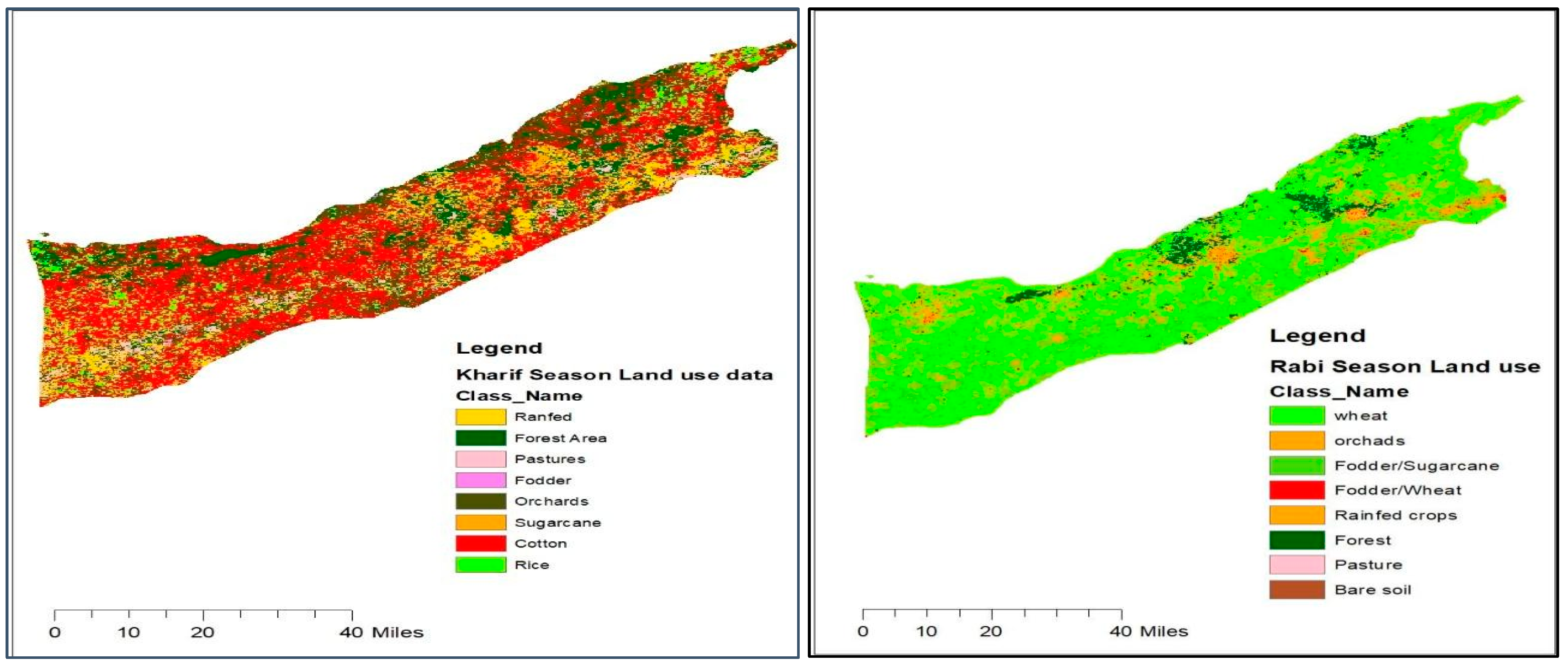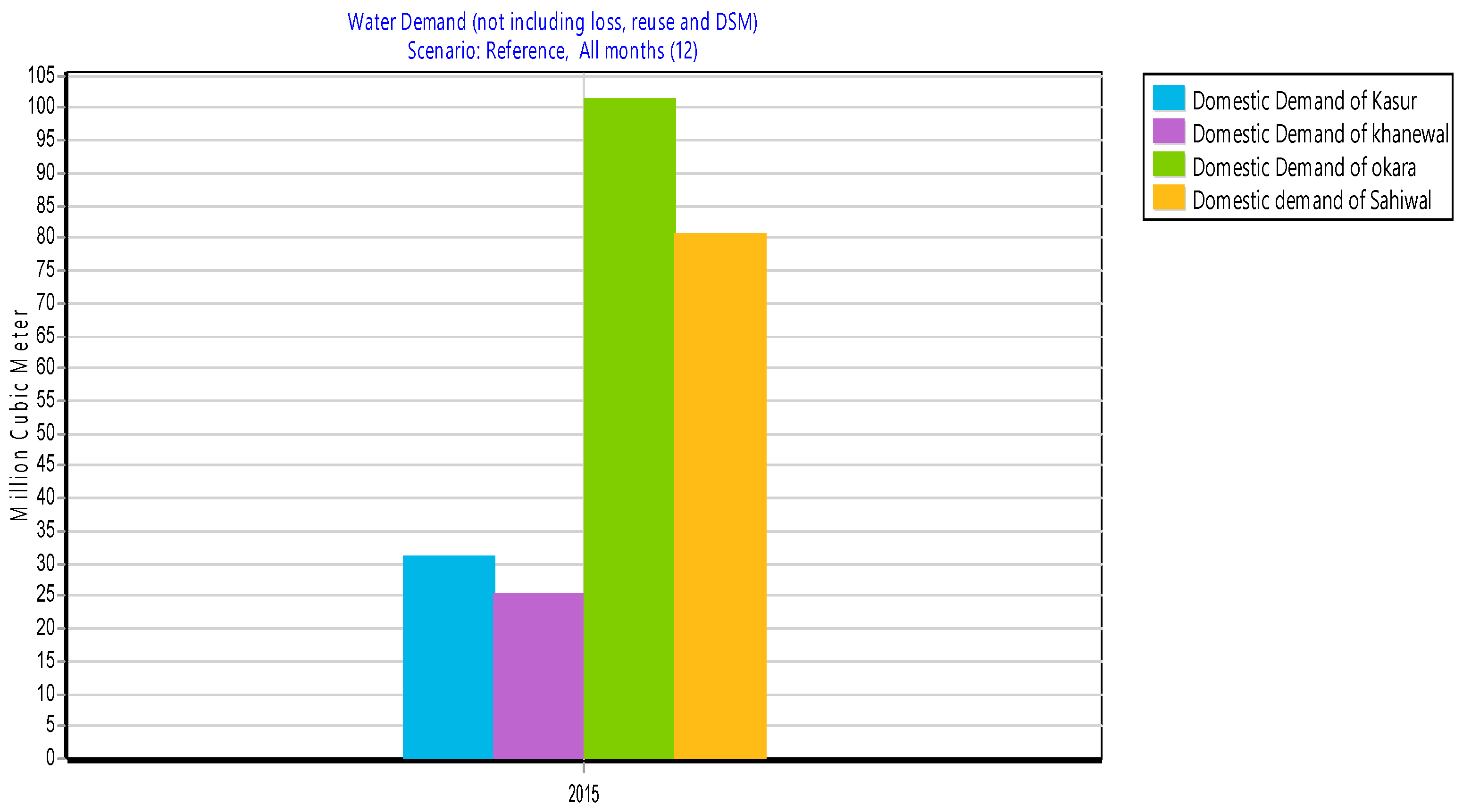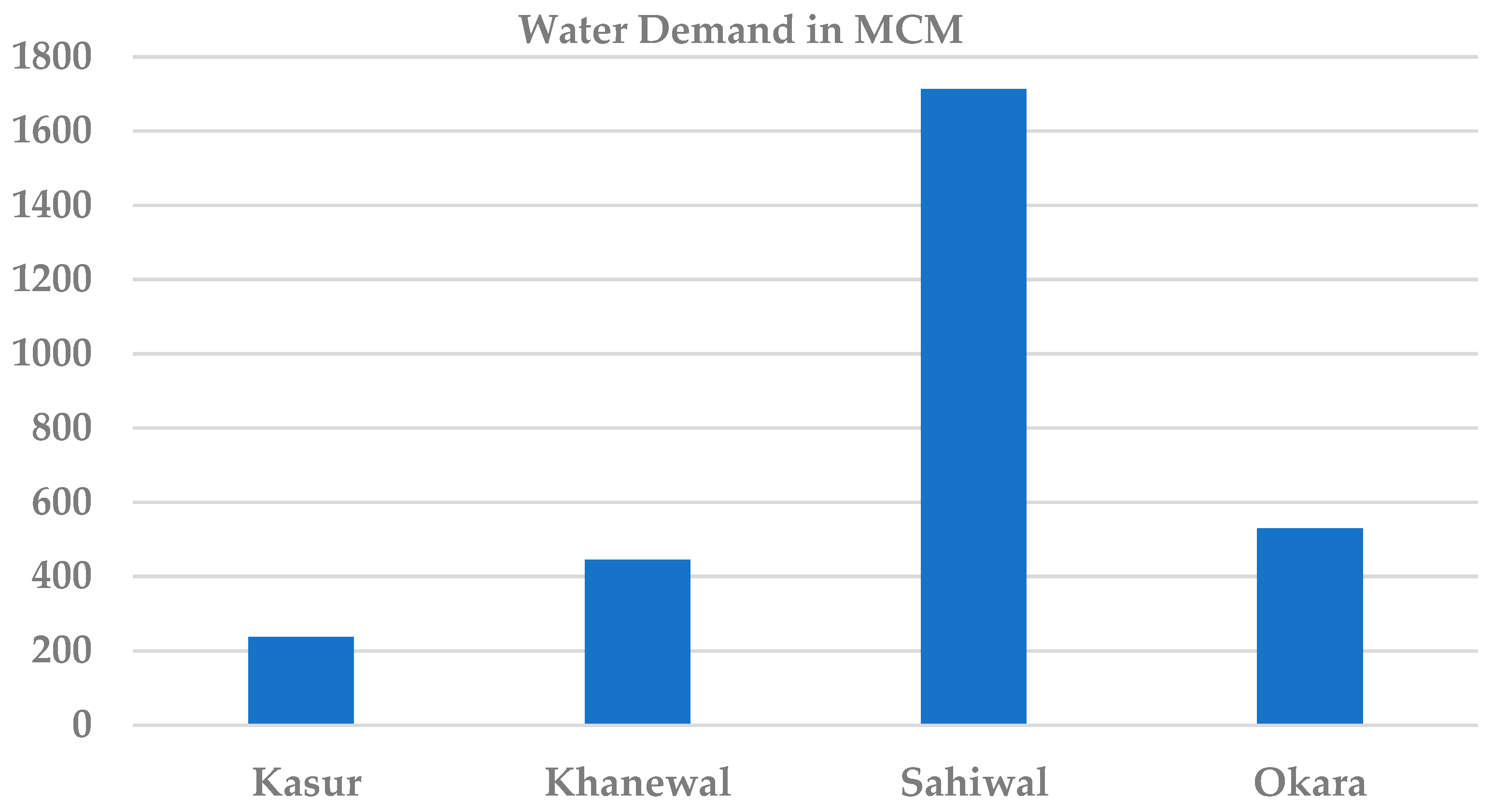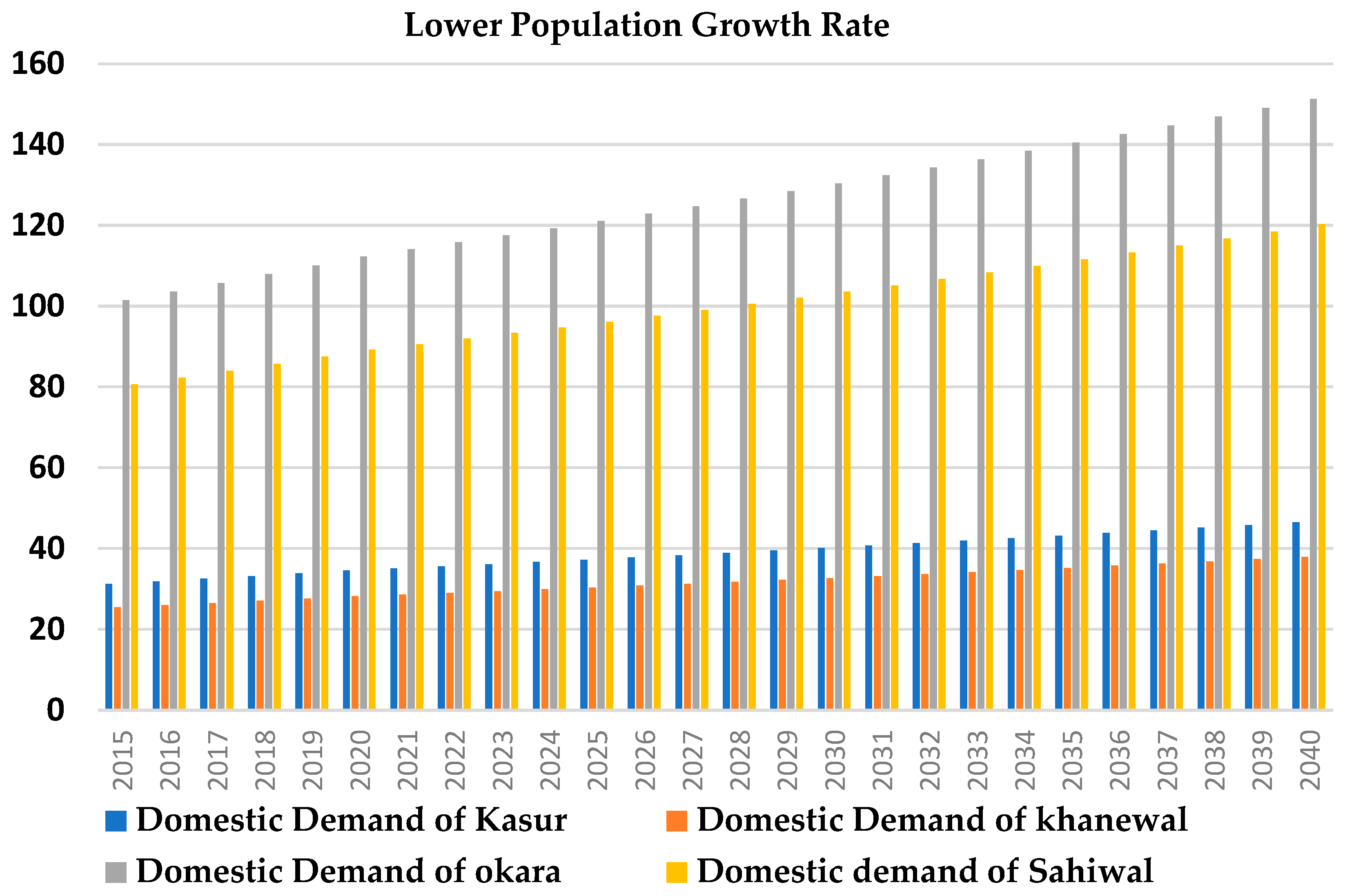Integrated Water Resource Management Using Water Evaluation and Planning Model: A Case Study of Lower Bari Doab Canal, Pakistan †
Abstract
:1. Introduction
2. Materials and Methods
2.1. Description of Study Area
2.2. Data Collection
2.2.1. Soil Data
2.2.2. Agricultural Land Utilization Data
3. Results and Discussion
3.1. Domestic Water Demand of Population within Districts for the Current Account Year (2015)
3.2. Water Demand for Agriculture for the Current Account Year (2015)
3.3. Unmet Demand for Kasur, Okara, Sahiwal, and Khanewal for the Current Account Year (2015)
3.3.1. Low Population Growth Rate
3.3.2. Medium Population Growth Rate
3.3.3. High Population Growth Rate
3.4. Higher Living Standard Scenario
4. Conclusions and Recommendations
Author Contributions
Funding
Institutional Review Board Statement
Informed Consent Statement
Data Availability Statement
Conflicts of Interest
References
- Oki, T.; Kanae, S. Global hydrological cycles and world water resources. Science 2006, 313, 1068–1072. [Google Scholar] [CrossRef] [PubMed]
- Anonymous. Global Risks Report 2019; World Economic Forum: Geneva, Switzerland, 2019; p. 114. [Google Scholar]
- Hoff, H.; Bonzi, C.; Joyce, B.; Tielbörger, K. A water resources planning tool for the Jordan River basin. Water 2011, 3, 718–736. [Google Scholar] [CrossRef]
- Ishaque, W.; Shaikh, S. Water and Energy Security for Pakistan; A retrospective analysis. Grassroots 2017, 51, 1–14. [Google Scholar]
- Mahmood, Z.; Liepach, W. A Productive, and Water-Secure Pakistan: Infrastructure, Institutions, Strategy, the Report of the Water Sector Task Force of the Friends of Democratic Pakistan; Water Sector Task Force: Islamabad, Pakistan, 2012. [Google Scholar]
- Hussain, I.; Hussain, Z.; Sial, M.; Akram, W.; Farhan, M. Water Balance, Supply and Demand and Irrigation Efficiency of Indus Basin. Water 2011, 49, 13–38. [Google Scholar]
- GOP. Pakistan Vision 2025: One Nationa—One Vision; Ministry of Planning Development and Reform: Islamabad, Pakistan, 2017. [Google Scholar]
- Rasul, G.; Sharma, B. The nexus approach to water–energy–food security: An option for adaptation to climate change. Clim. Policy 2016, 16, 682–702. [Google Scholar] [CrossRef]
- Levite, H.; Sally, H.; Cour, J. Testing water demand management scenarios in a water-stressed basin in South Africa: Application of the WEAP model. Phys. Chem. Earth 2003, 28, 779–786. [Google Scholar] [CrossRef]
- Hassan, D.; Rais, M.; Ahmed, W.; Bano, R.; Burian, S.; Ijaz, M.; Bhatti, F. Future water demand modeling using water evaluation and planning: A case study of the Indus Basin in Pakistan. Sustain. Water Resour. Manag. 2019, 5, 1903–1915. [Google Scholar] [CrossRef]
- Amin, A.; Iqbal, J.; Asghar, A.; Ribbe, L. Analysis of current and future water demands in the Upper Indus Basin under IPCC climate and socio-economic scenarios using a hydroeconomic WEAP Model. Water 2018, 10, 537. [Google Scholar] [CrossRef]










| Data | Sources | Time |
|---|---|---|
| Climatic data | Pakistan Meteorological Dept., Monthly and global assembled and satellite datasets | Daily, Monthly |
| Flows of LBDC | Irrigation department, GOP | Daily |
| Land use data | MODIS | Yearly |
| Soil data | World Soil map. | Daily Discharge data |
| Population (District wise), Water consumption, Growth rate | Pakistan Bureau of Statistics, World Bank Data | Yearly record |
| Sr. no. | SNUM | Soil Types |
|---|---|---|
| 1 | 3736 | Clay Loam |
| 2 | 3878 | Loam |
| 3 | 3883 | Clay Loam |
Disclaimer/Publisher’s Note: The statements, opinions and data contained in all publications are solely those of the individual author(s) and contributor(s) and not of MDPI and/or the editor(s). MDPI and/or the editor(s) disclaim responsibility for any injury to people or property resulting from any ideas, methods, instructions or products referred to in the content. |
© 2023 by the authors. Licensee MDPI, Basel, Switzerland. This article is an open access article distributed under the terms and conditions of the Creative Commons Attribution (CC BY) license (https://creativecommons.org/licenses/by/4.0/).
Share and Cite
Khanam, H.; Ali, S.; Zaman, M.; Shahid, M.A.; Muzammal, H.; Khan, M.Z.; Safdar, M.; Majeed, M.D. Integrated Water Resource Management Using Water Evaluation and Planning Model: A Case Study of Lower Bari Doab Canal, Pakistan. Environ. Sci. Proc. 2023, 25, 55. https://doi.org/10.3390/ECWS-7-14202
Khanam H, Ali S, Zaman M, Shahid MA, Muzammal H, Khan MZ, Safdar M, Majeed MD. Integrated Water Resource Management Using Water Evaluation and Planning Model: A Case Study of Lower Bari Doab Canal, Pakistan. Environmental Sciences Proceedings. 2023; 25(1):55. https://doi.org/10.3390/ECWS-7-14202
Chicago/Turabian StyleKhanam, Hira, Sikandar Ali, Muhammad Zaman, Muhammad Adnan Shahid, Hafsa Muzammal, Muhammad Zeeshan Khan, Muhammad Safdar, and Muhammad Danish Majeed. 2023. "Integrated Water Resource Management Using Water Evaluation and Planning Model: A Case Study of Lower Bari Doab Canal, Pakistan" Environmental Sciences Proceedings 25, no. 1: 55. https://doi.org/10.3390/ECWS-7-14202
APA StyleKhanam, H., Ali, S., Zaman, M., Shahid, M. A., Muzammal, H., Khan, M. Z., Safdar, M., & Majeed, M. D. (2023). Integrated Water Resource Management Using Water Evaluation and Planning Model: A Case Study of Lower Bari Doab Canal, Pakistan. Environmental Sciences Proceedings, 25(1), 55. https://doi.org/10.3390/ECWS-7-14202







